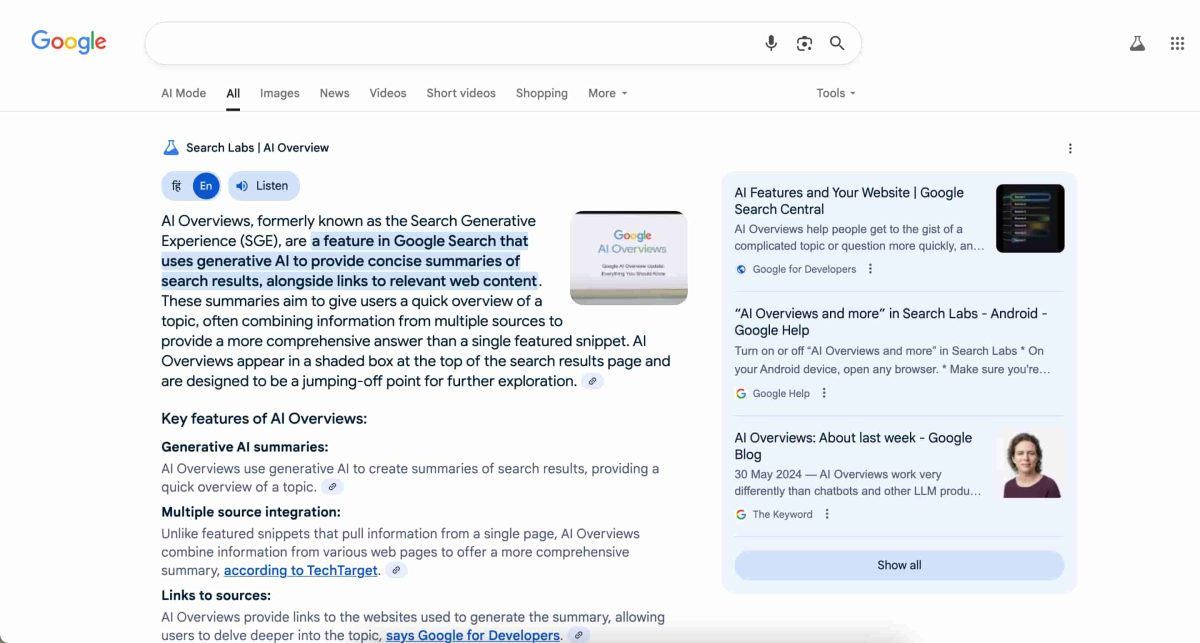Search is changing. Google AI Overviews, ChatGPT, and Perplexity no longer rely only on traditional rankings. They pull direct answers from content they can read, parse, and trust.
But here’s the truth: even great content won’t show up in AI Overviews if your page has technical issues.
To help, here’s a quick, simple checklist that shows how to make every page AIO-ready – in just 15 minutes.
Why Technical SEO for AI Matters
AI search platforms use retrieval-augmented generation (RAG). They need to:
- Access your page
- Understand its structure
- Pull clean, clear content
If your site is slow, blocked by robots.txt, has poor mobile views, or uses confusing code, AI systems may ignore it—even if it ranks.
That’s why technical readiness is essential for AI citations.
The 15-Minute AIO-Ready Checklist
Spend 1–2 minutes per task. These quick checks can make a big difference in visibility across Google AI Mode, Perplexity, and ChatGPT.
1. Check Crawlability
Use Google Search Console’s URL Inspection Tool.
- Confirm “URL is on Google”
- Look for recent crawl dates
- Fix noindex tags, blocked robots.txt, or crawl errors
2. Test Mobile Access
Use dev tools or a real device.
- Content should be visible on small screens
- No hidden menus or collapsed elements
- Text must be readable without zooming
3. Measure Page Speed
Use PageSpeed Insights.
Slow pages often fail to load in time for AI bots.
4. Inspect Source HTML
Right-click > View Source.
- Make sure content is present in raw HTML
- Avoid relying on JavaScript to load key sections
5. Fix Heading Structure
Use clear, logical headings.
- Only one
<h1>per page - Use
<h2>for main topics,<h3>for subtopics - Don’t skip levels
6. Add Schema Markup
Test with Google’s Rich Results tool.
- Use the correct schema (Article, FAQ, Product)
- Make sure it’s valid and complete
- Avoid syntax errors
7. Check Canonical Tags
Search for rel="canonical" in the page source.
- Should self-reference (point to itself)
- Avoid duplicate or outdated canonicals
8. Test Readability
Use the Flesch Reading Ease test.
- Score should be above 60
- Use short paragraphs and active voice
- Avoid jargon or long sentences
9. Review Internal Links
AI loves context.
- Link to related pages using descriptive anchor text
- Avoid “click here” or “read more”
- Reinforce topic clusters
10. Check AI Bot Access (Cloudflare Users)
As of June 2025, Cloudflare blocks AI bots by default.
- Go to your Cloudflare dashboard
- Make sure AI crawlers (e.g., Google-Extended, ChatGPT-User) are allowed
- Avoid accidental blocking or opt-out policies
How to Use This Checklist
You don’t need a full site audit. Just use this list:
- Before publishing a new page
- While updating old content
- During quarterly reviews of key pages
- If AI isn’t citing you despite strong rankings
Create a shared spreadsheet. Mark each item pass/fail. Fix the pages that score lowest first.
Who Should Do What?
To get this right, divide the tasks:
- Content teams: Headings, readability, internal links
- SEO teams: Schema, canonicals, structure
- Dev teams: Speed, crawlability, HTML access
Train new hires using before/after examples of pages that passed vs failed this checklist.
Final Thoughts
Ranking on Google is no longer enough. If AI systems can’t retrieve your content, they won’t cite it—no matter how good it is.
Focus on technical clarity. Fast pages, structured content, and open access are now the keys to visibility in AI search.
Use this checklist to make your most important pages AI-friendly, crawlable, and citation-ready.

